If you haven’t gotten the chance to visit our new offices yet, here’s a sneak peek from our friends […]
Happy New Year!
We hope you and your family had a wonderful holiday season.
As we run into 2023, know we’re looking forward to seeing you this year.
If you haven’t gotten the chance to visit our new offices yet, here’s a sneak peek from our friends at TENFOLD, who brought our interior design dreams to life in our new Easton space.
Team Updates

Meet our newest team member, Keegan VanMeter:
- Keegan joined Summit in September 2022.
- Prior to joining full time, Keegan worked as an intern for Summit.
- He graduated Magna Cum Laude from Ohio University with a Bachelor of Business Administration specializing in Finance. During his time at Ohio U, Keegan worked alongside peers managing a Fixed Income portfolio and was in the Select Leadership Development Group.
- Keegan is from Granville, Ohio and currently resides in Granville with his wife and daughter.

Roman Korolchuk joined Summit in the Spring of 2018 and was an invaluable member of our team from the beginning. Recently, Roman’s hard work and impressive skills have earned him the title of Associate Advisor. We look forward to many more years to come with Roman.
Smart Tip
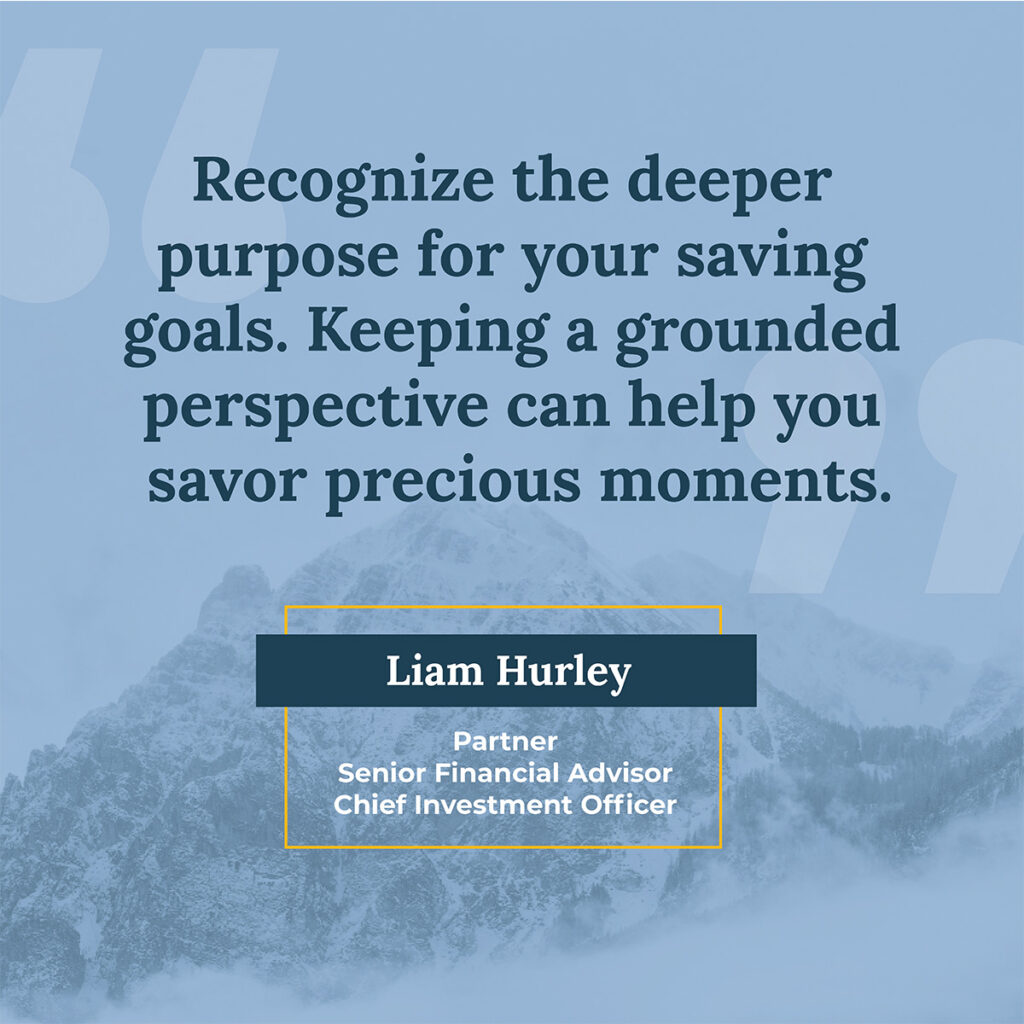
Investment Commentary
Alexander and the Terrible, Horrible, No Good, Very Bad Day, a children’s book authored by Judith Viorst, was published in 1972. Fifty years later, the title provided a very good description of the investment markets we experienced for pretty much the entire year of 2022. No doubt that 2022 will be studied by our children and grandchildren in their future college investment classes. Let’s take a look at what made it such a terrible, horrible, no good, very bad year…
The Stock Market
After setting an all-time high on January 4, 2022, the S&P 500 total return was off 18.6% in 2022, with a low point in October down 24%. Going back to 1926, only 5 years have concluded with a bigger decline. Not only is that a dramatic decrease, but the volatility in getting there was very brutal. There were 63 days this year where the S&P 500 fell 1% or more. Looking back to 1940, there have only been 3 years since then with more 1+% declines (1974, 2002, 2008).
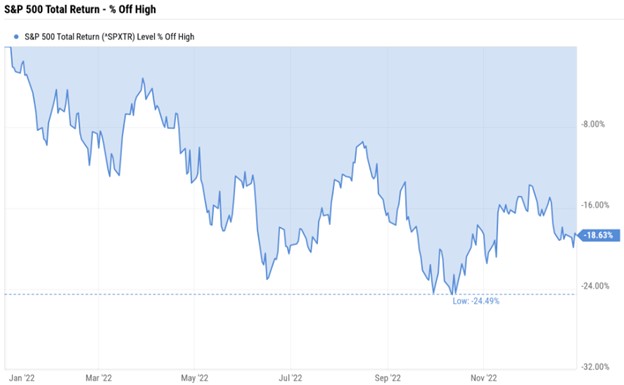
The Bond Market
An even bigger outlier than the stock market was the bond market. Going back to 1976, there have only been 3 other years where the total return of the Aggregate Bond Index (“The Agg”) has been negative, with the biggest loss being 2.92% in 1994. However, 2022 roared past that mark with “The Agg” losing 13.01% – roughly a 10% greater loss than the previous worst year. Historically the fixed income allocation of portfolios typically zig when stock markets zag, but in 2022 the two asset classes exhibited a high correlation and did not provide the diversification that is normally achieved.
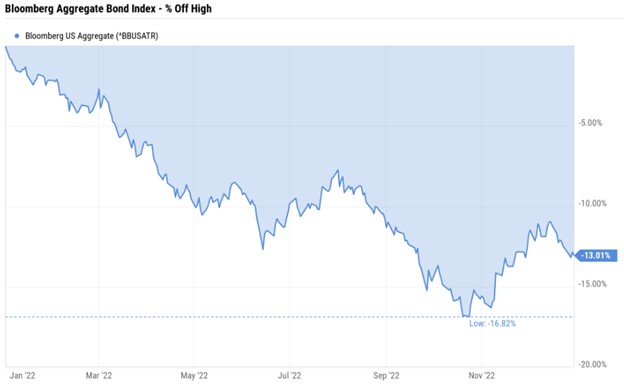
This high correlation led to the second worst performance of a traditional 60/40 model (60% allocation to stocks and 40% allocation to bonds) since the creation of the Aggregate Bond Index, with only 2008 posting lower returns.
Inflation
Inflation peaked in June at 9.1%, which is the highest we have seen in the US since 1980. Recall 1979-1981 is when Paul Volcker and the Fed hiked the Fed Funds rate to 20% to get double digit inflation under control. Fortunately, it does not seem that Jerome Powell and the current Fed will need to do anything close to that, though rate hikes of 425 basis points in 2022 have brought pain and volatility to financial markets.
The most recent inflation reading was at 7.1%, and the last two readings came in with cooler (lower) inflation than the market expected. We are closing out 2022 with inflation almost identical to where the year started, but still we are dramatically higher than 1 year prior to that.
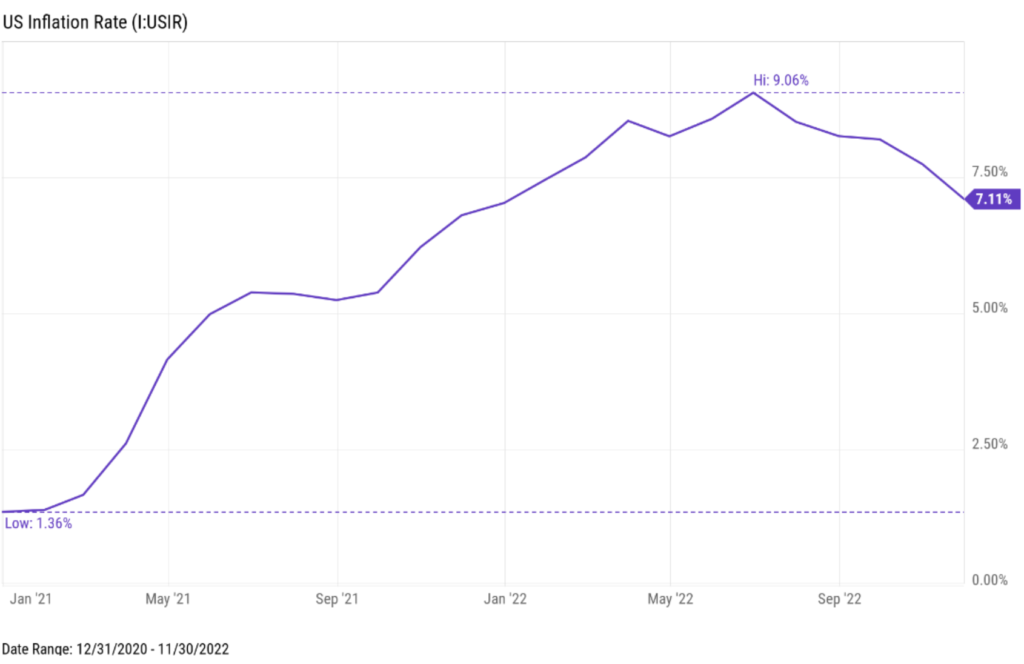
Anecdotally, we see inflation slowing in many areas of daily life. Used car lots are starting to have inventory again and prices have fallen between 5 to 15% since this summer. Gasoline prices have also been declining in the second half of the year. Futures markets are pricing in expected average annual US inflation rates of 2.9% for the next 5 years and 2.2% for the following 5 years.
Interest Rates
When the Fed started the post-Great Financial Crisis hiking cycle in 2015, it took 3 years and 9 hikes of 25 basis points (bps) to move from 0% to 2.25%. In 9 months and 7 Fed meetings in 2022, the Fed hiked from 0% to 4.25%. Prior to 2022, the last time the Fed hiked 75 bps was November of 1994. In ’22 the Fed hiked 75 bps 4 meetings in a row.
The Fed uses interest hikes as a primary tool to cool inflation. By making money “more expensive”, the demand for assets (oil, cotton, copper, stocks, bonds) decreases. The Fed is in a tough spot to reduce consumer and business spending enough to get inflation under control while attempting to not throw the economy into a recession. One of the inputs to a recession predicting model from the New York Fed is the spread between the yield on the 10 year US Treasury Bond and the 3 month US Treasury Bill. That spread in mid-December was -0.9%, which is a wider negative spread than any point since 1980. Historically, as shown in the chart below, recessions (indicated by the gray bands) have tended to occur 4 to 6 quarters after the 10-year minus 3-month Treasury spread has gone negative.
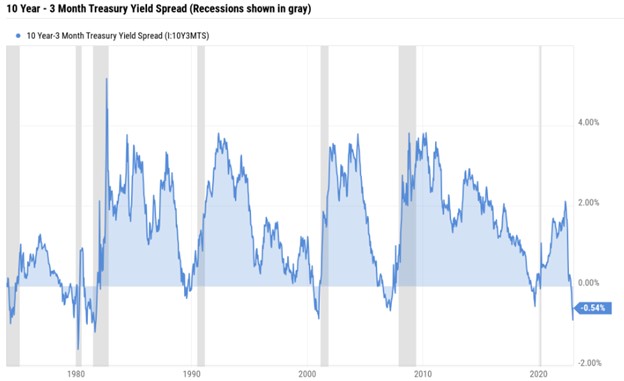
2023
So where does that leave us looking forward to 2023? The Fed still has a lot of work to do to achieve their goal of 2% inflation, but all indications say we are much closer to the end of the hiking cycle than the beginning of it. The inverted yield curve is pointing to a recession; however, the consumer and businesses used the zero-rate period post-Covid to clean up their balance sheets – homeowners and business both used that time to refinance their debt to historically low rates. That bodes well for credit events and stresses we typically see during recessions, and may indicate if a recession does occur, the length and depth may not be that severe. If we do dip into a recession, it will be one of the most anticipated recessions in history, and many financial assets have been priced accordingly.
When we review long-term capital market assumptions for expected risk and returns of various asset classes. We believe the lower valuations and higher yields of today mean that asset markets offer attractive long-term returns, but likely with continued volatility until the Fed rate hikes have ended (and perhaps a bit longer). But after a year of turmoil, the core principles of investing still hold firm and your Investment Policy Statement remains the most appropriate guide for investment decisions. Your Summit advisor is available to discuss your personal situation.
Quick Links
| About Summit | Important Disclosures | Access Your Portfolio Reports | Investment Philosophy Presentation |
